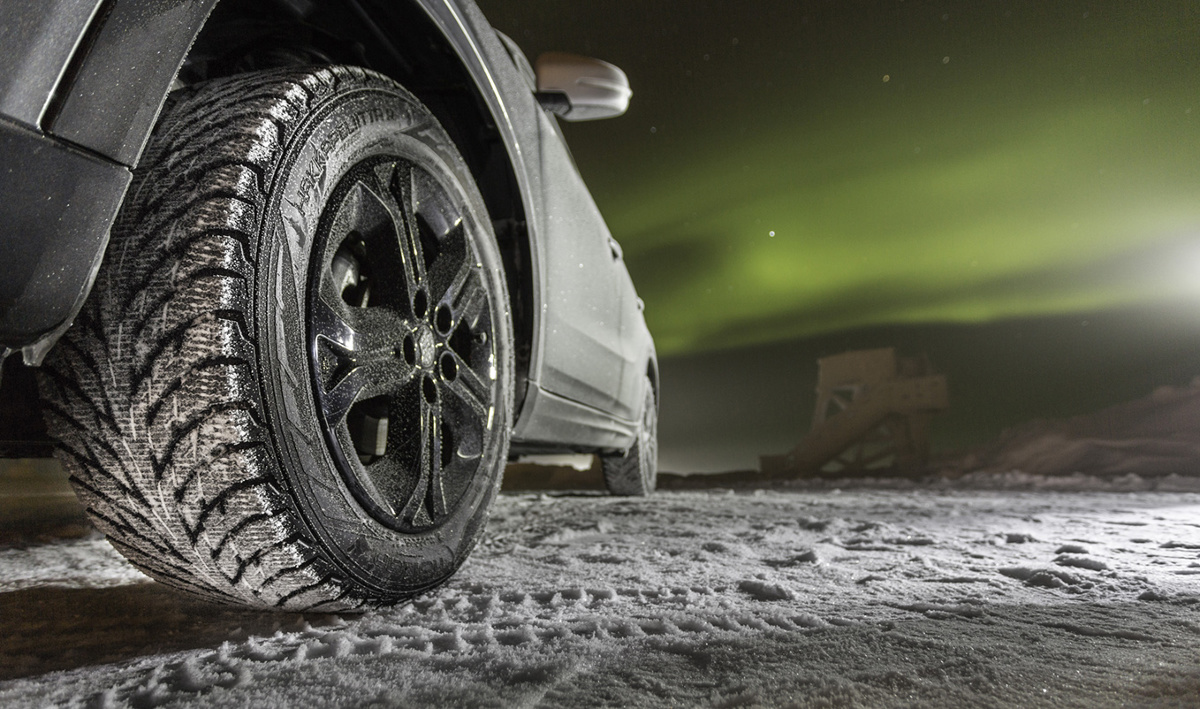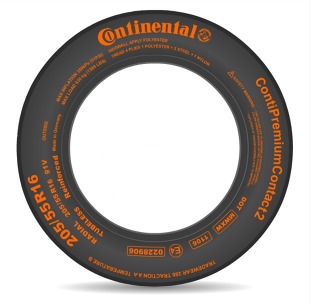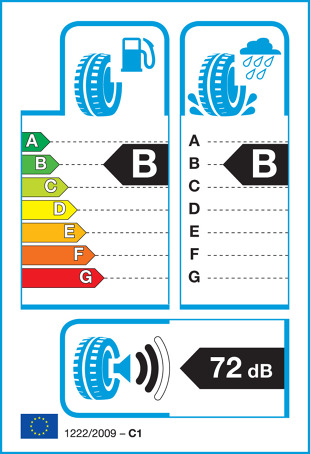
Tire markings. What do they report, how to read them, where to look for them?
 The right choice of car tires is crucial for safety and driving comfort. Each tire is described by the manufacturer with a variety of markings. You can read about how not to make a mistake and make the right choice in our guide.
The right choice of car tires is crucial for safety and driving comfort. Each tire is described by the manufacturer with a variety of markings. You can read about how not to make a mistake and make the right choice in our guide.
SIZE
The most important parameter and the main criterion for choosing a tire is its size. On the sidewall it is indicated in the format, for example, 205/55R16. The first number indicates the width of the tire, expressed in millimeters, the second - the profile, which is the percentage of the height of the tire to its width. After doing the calculations, we find out that in the tire of our example it is 112,75 mm. The third parameter is the diameter of the rim on which the tire is mounted. Failure to comply with the vehicle manufacturer's recommendations regarding tire size can lead, for example, to wheel arch friction if tires that are too wide are used.
SEASON
 There is a basic division into 3 seasons for which tires are intended. We distinguish between winter, all-season and summer tyres. We recognize winter tires by the 3PMSF or M+S marking. The first is an extension of the English abbreviation Three Peak Mountain Snowflake. It appears as a symbol of a triple mountain peak with a snowflake. This is the only winter tire label that complies with EU and UN directives. This symbol was introduced in 2012. In order for a manufacturer to be able to put it on their product, the tire must pass a series of tests that confirm its safe behavior on snow. The symbol M+S, which can be found on mud and winter tires, is an abbreviation of the English term Mud and Snow. Attention! This means that the tread of this tire can handle mud and snow, but not a winter tire! Therefore, if there is no other sign next to this marking, check with the seller or on the Internet what type of tire you are dealing with. Manufacturers label all-season rubbers with the word All Season or symbols representing the four seasons. Summer tires are marked with a rain or sun cloud symbol, but this is by no means standardized and depends solely on the manufacturer.
There is a basic division into 3 seasons for which tires are intended. We distinguish between winter, all-season and summer tyres. We recognize winter tires by the 3PMSF or M+S marking. The first is an extension of the English abbreviation Three Peak Mountain Snowflake. It appears as a symbol of a triple mountain peak with a snowflake. This is the only winter tire label that complies with EU and UN directives. This symbol was introduced in 2012. In order for a manufacturer to be able to put it on their product, the tire must pass a series of tests that confirm its safe behavior on snow. The symbol M+S, which can be found on mud and winter tires, is an abbreviation of the English term Mud and Snow. Attention! This means that the tread of this tire can handle mud and snow, but not a winter tire! Therefore, if there is no other sign next to this marking, check with the seller or on the Internet what type of tire you are dealing with. Manufacturers label all-season rubbers with the word All Season or symbols representing the four seasons. Summer tires are marked with a rain or sun cloud symbol, but this is by no means standardized and depends solely on the manufacturer.
The editors recommend:
Driver attention. Even a fine of PLN 4200 for a slight delay
Entrance fee to the city center. Even 30 PLN
An expensive trap many drivers fall into
SPEED INDEX
The speed rating indicates the maximum speed allowed by the tire. Designated by one letter (see table below). The speed index must correspond to the characteristics of the car, although it is possible to install tires with an index lower than the maximum speed that the car develops - mainly in the case of winter tires. A higher speed index means the tire is made from a harder compound, so lower speed tires can provide slightly more comfort.
M - do 130 km / h
H - 140 km/h
P - do 150 km / h
Q - do 160 km/h
P - do 170 km / h
S - do 180 km / h
T - do 190 km / h
H - 210 km/h
V - do 240 km / h
W - do 270 km/h
Y - do 300 km / h
LOAD INDEX
 The load index describes the maximum allowable load on the tire at the speed indicated by the speed index. The load capacity is indicated by a two-digit or three-digit number. The load index is of particular importance in the case of minibuses and minibuses. Both in the case of the speed index and the load index, care should be taken to ensure that tires that differ in these parameters are not installed on the same axle of the vehicle. Additionally, XL, RF or Extra Load labels indicate a tire with increased load capacity.
The load index describes the maximum allowable load on the tire at the speed indicated by the speed index. The load capacity is indicated by a two-digit or three-digit number. The load index is of particular importance in the case of minibuses and minibuses. Both in the case of the speed index and the load index, care should be taken to ensure that tires that differ in these parameters are not installed on the same axle of the vehicle. Additionally, XL, RF or Extra Load labels indicate a tire with increased load capacity.
85 – 515 kg/rail
86 – 530 kg/rail
87 – 545 kg/rail
88 – 560 kg/rail
89 – 580 kg/rail
90 – 600 kg/rail
91 – 615 kg/rail
92 – 630 kg/rail
93 – 650 kg/rail
94 – 670 kg/rail
95 – 690 kg/rail
96 – 710 kg/rail
97 – 730 kg/rail
98 – 750 kg/rail
99 – 775 kg/rail
100 – 800 kg/rail
101 – 825 kg/rail
102 – 850 kg/rail
ASSEMBLY GUIDE
 Manufacturers put information on tires that must be followed when installing them. The most common indicator is ROTATION combined with an arrow to show the direction in which the tire should rotate while driving. The second type of information is the inscriptions OUTSIDE and INSIDE, indicating on which side of the wheel (inside or outside) this tire wall should be located. In this case, we can freely change the wheels of the car from left to right, as long as they are correctly installed on the rims.
Manufacturers put information on tires that must be followed when installing them. The most common indicator is ROTATION combined with an arrow to show the direction in which the tire should rotate while driving. The second type of information is the inscriptions OUTSIDE and INSIDE, indicating on which side of the wheel (inside or outside) this tire wall should be located. In this case, we can freely change the wheels of the car from left to right, as long as they are correctly installed on the rims.
PRODUCTION ДАННЫЕ
Information about the date of manufacture of the tire is contained in the code on one side of the tire, starting with the letters DOT. The last four digits of this code are important as they hide the week and year of manufacture. For example - 1017 means that the tire was produced in the 10th week of 2017. Both the tire turnover standard set by the Polish Committee for Standardization and the position of the largest tire concerns are the same - a tire is considered new and fully valuable for up to three years from the date of its production. The condition is that it should be stored vertically, and the fulcrum should be changed at least once every 6 months.
PRESSURE
The maximum allowable tire pressure is preceded by the text Max Inflation (or just MAX). This value is most often given in units of PSI or kPa. In the case of normal use of the car, we are unlikely to exceed this parameter. Information about this can be important when storing wheels with high tire pressure - this procedure is sometimes used to avoid deformation of the rubber. When doing this, be careful not to exceed the permissible tire pressure.
OTHER MARKINGS
Tires suitable for loss of pressure, depending on the manufacturer, may have the following marking on the sidewall:
Manufacturer | sign | needs |
Bridgestone | RFT (Run-Falt Technology) | Does not require a special rim |
Continental | SSR (Self-Sustaining Runflat) | Does not require a special rim |
A Good Year | RunOnFlat | Does not require a special rim |
Dunlop | RunOnFlat | Does not require a special rim |
Pirelli | Self-supporting treadmill | Recommended rim Eh1 |
Michelin | ZP (zero pressure) | Recommended rim Eh1 |
Yokohama | ZPS (zero pressure system) | Does not require a special rim |
In each case, it is a tire with reinforced sidewalls so that it can be driven at speeds of up to 80 km/h for a maximum of 80 km, unless otherwise specified in the vehicle's owner's manual. The abbreviations DSST, ROF, RSC or SST can also be found on tires that allow movement after loss of pressure.
 Tubeless tires are marked with the word TUBELESS (or the abbreviation TL). Tube tires currently make up a small percentage of tire production, so there is little chance of finding one on the market. The XL (Extra Load) or RF (Reinforced) marking is also used in tires with a reinforced structure and increased load capacity, RIM Protector - the tire has solutions that protect the rim from damage, RETREAD is a retreaded tire, and FP (Fringe Protector) or RFP ( Rim Fringe Protector is a tire with a coated rim. Dunlop uses the MFS symbol. In turn, TWI is the location of the tire tread wear indicators.
Tubeless tires are marked with the word TUBELESS (or the abbreviation TL). Tube tires currently make up a small percentage of tire production, so there is little chance of finding one on the market. The XL (Extra Load) or RF (Reinforced) marking is also used in tires with a reinforced structure and increased load capacity, RIM Protector - the tire has solutions that protect the rim from damage, RETREAD is a retreaded tire, and FP (Fringe Protector) or RFP ( Rim Fringe Protector is a tire with a coated rim. Dunlop uses the MFS symbol. In turn, TWI is the location of the tire tread wear indicators.
From November 1, 2012, every tire manufactured after June 30, 2012 and sold in the European Union must have a special sticker containing the most important information about the safety and environmental aspects of the tyre. The label is a rectangular sticker attached to the tire tread. The label contains information about the three main parameters of the purchased tire: economy, grip on wet surfaces and the noise generated by the tire while driving.
Economy: seven classes are defined, from G (least economical tyre) to A (most economical tyre). Economy may vary depending on vehicle and driving conditions. Wet grip: seven classes from G (longest braking distance) to A (shortest braking distance). The effect may vary depending on the vehicle and driving conditions. Tire noise: one wave (pictogram) is a quieter tire, three waves is a noisier tire. In addition, the value is given in decibels (dB).
